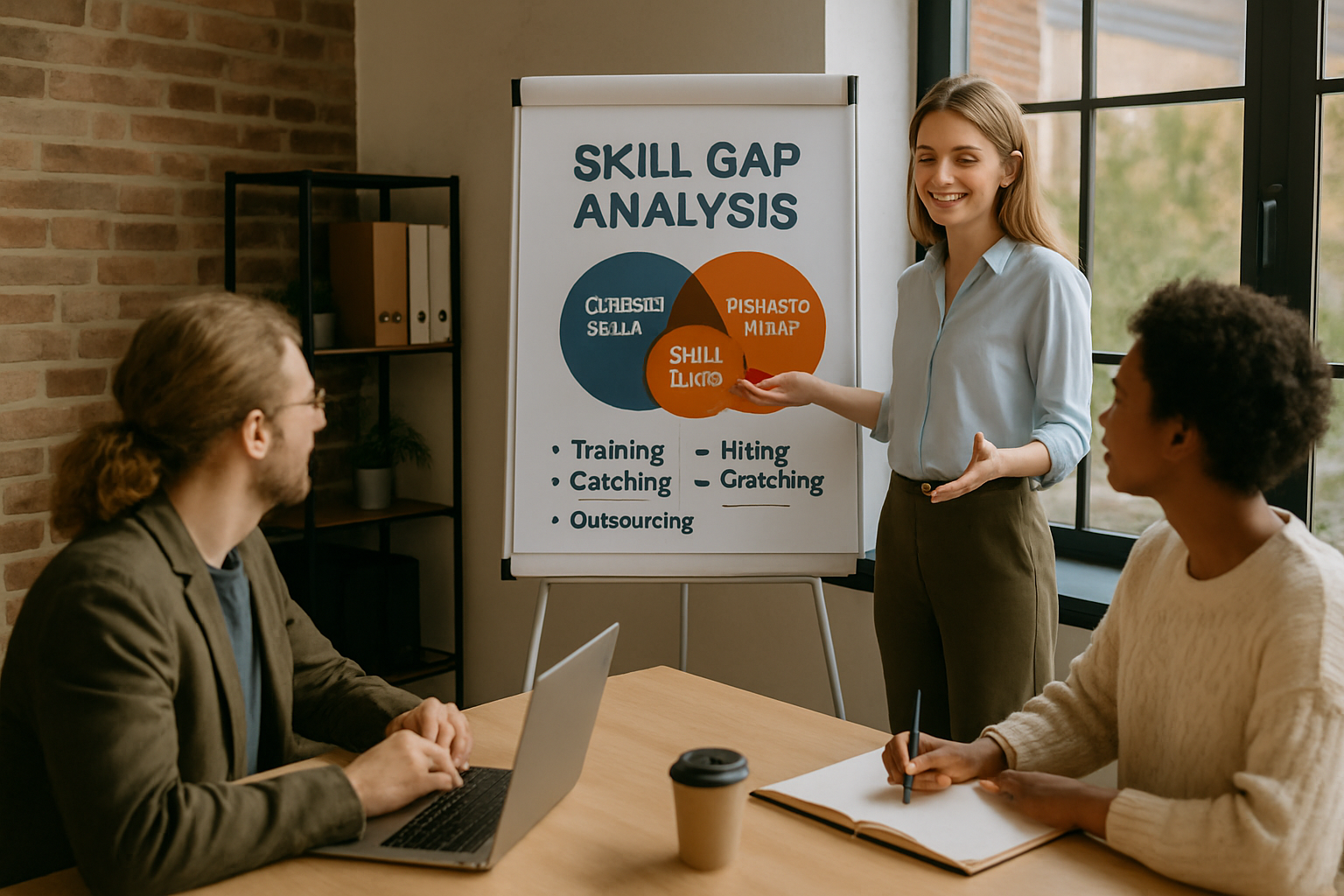
Skill gap analysis methods
In the fast-evolving landscape of technology and the workplace, understanding and bridging skill gaps is more critical than ever. Whether shaping the future of women in tech, supporting neurodivergent learners, or ensuring organizations remain competitive, skill gap analysis stands as a foundational tool. But what does it really mean to analyze skill gaps, and how can you approach this process in a way that is both actionable and genuinely transformative?
Defining Skill Gap Analysis
At its core, skill gap analysis is a systematic process to identify the difference between the skills an organization or individual currently possesses and those required to achieve specific goals. This gap can be technical—like proficiency in a new programming language—or soft, such as collaboration or creativity. Regardless of the context, the process is rooted in honest assessment and a commitment to growth.
“Skill gap analysis isn’t about highlighting deficiencies—it’s about illuminating possibilities.”
Whether you are responsible for workforce development, a manager planning your team’s future, or an individual mapping your career, skill gap analysis is a powerful compass.
Key Methods of Skill Gap Analysis
There is no one-size-fits-all approach. Instead, a thoughtful skill gap analysis blends several methods, choosing those best suited to organizational culture, resources, and goals. Let’s explore some of the most effective methods and how to put them into action.
1. Surveys and Self-Assessments
These tools invite employees or learners to rate their own competence in relevant skills. Used thoughtfully, they provide a valuable snapshot of perceived strengths and areas for growth. The key is specificity: instead of asking, “Are you good at coding?” ask about concrete tasks—“Can you build a RESTful API using Node.js?”
Tips for effective surveys:
- Use clear, objective language.
- Include both technical and soft skills.
- Enable open-ended responses for nuance.
- Normalize honest self-reflection by emphasizing growth, not judgment.
Example:
At a mid-sized fintech company, employees complete a quarterly self-assessment covering current and emerging technologies. The results inform individualized learning plans and company-wide training priorities.
2. Managerial Assessments and 360-Degree Feedback
While self-assessment is valuable, it can be limited by blind spots or self-doubt. Incorporating managerial feedback and 360-degree evaluations—where peers, direct reports, and supervisors all provide input—creates a richer picture. This method is particularly effective for evaluating soft skills and leadership potential.
Tips:
- Offer training for managers and peers on giving constructive, unbiased feedback.
- Use examples to anchor feedback in real-world tasks and outcomes.
- Pair feedback with actionable next steps, not just ratings.
“A growth-oriented culture transforms feedback from a source of anxiety to a catalyst for learning.”
3. Skills Inventories and Competency Matrices
For larger teams or organizations, maintaining a skills inventory—a database of current employee skills—enables rapid identification of gaps. A competency matrix takes this further, mapping required skills for each role against current team capabilities.
Actionable Steps:
- List all critical skills for each function or role.
- Rate each team member’s proficiency—beginner, intermediate, advanced.
- Identify roles or projects at risk due to skill shortages.
This method is especially powerful for planning reskilling initiatives or hiring priorities.
4. Job Task Analysis
Sometimes, the best insights come from observing the actual work. Job task analysis involves breaking down core responsibilities into specific tasks and mapping the skills needed for each. This granular approach helps uncover hidden gaps—perhaps a team excels at developing code but struggles with version control or documentation.
Job shadowing, interviews, and workflow analysis all contribute to a robust job task analysis. Invite employees to describe a “day in the life” and compare their narratives to job descriptions and strategic goals.
5. Performance Reviews and Business Outcomes
Linking skill gaps to measurable outcomes—such as project delivery times, product quality, or customer satisfaction—grounds the analysis in impact. If a team consistently misses deadlines due to bottlenecks in code review, there may be a need for upskilling in collaborative development tools or peer review practices.
Look beyond the numbers. Qualitative insights from customer feedback or post-mortem project reviews can highlight skills that make—or break—success.
Special Considerations: Women in Tech and Neurodivergent Learners
Most skill gap analysis frameworks assume a “typical” learner or employee. But in reality, workplaces are rich tapestries of diverse experience, perspective, and learning style. Nowhere is this more evident than in the advancement of women in technology and the support of neurodivergent learners.
Addressing Bias in Skill Assessment
Traditional assessments often unintentionally reflect and reinforce systemic biases. For example, women in tech may be rated lower on “confidence” or “leadership” skills due to stereotypes, regardless of actual performance. Neurodivergent employees—such as those with ADHD or autism—may excel in technical analysis but struggle with standard communication benchmarks.
Strategies to ensure equity:
- Use multiple assessment methods to capture diverse strengths.
- Ensure evaluators are trained in bias awareness.
- Design skill matrices that value a broad spectrum of abilities, including creativity, resilience, and unconventional problem-solving.
“The most innovative teams are those that recognize and celebrate difference—not just in background, but in skillset and perspective.”
Neurodiversity-Inclusive Analysis
Neurodivergent individuals often bring unique skills—hyperfocus, pattern recognition, creative problem-solving—yet may find traditional assessments limiting. Adapting skill gap analysis can unlock potential:
- Allow alternative ways to demonstrate skills (project portfolios, code samples, peer presentations).
- Value non-linear career paths and self-taught expertise.
- Provide flexible timelines for assessments.
These adaptations benefit everyone, not just neurodivergent team members. They encourage a culture where growth and learning are accessible to all.
Integrating Technology: Tools for Modern Skill Gap Analysis
The digital transformation of learning and HR has supercharged skill gap analysis. Today, a range of platforms—many powered by artificial intelligence—can automate much of the process, freeing leaders and learners to focus on action.
Learning Management Systems (LMS)
Modern LMS platforms allow organizations to map required skills to curated content, track employee progress, and identify learning needs at scale. Many systems offer built-in assessment tools and integrate with competency frameworks.
AI-Powered Assessment Tools
AI-driven platforms can analyze everything from code samples to written reports, providing objective skill ratings and personalized recommendations. For example, platforms like Codility or HackerRank offer real-time coding challenges and analytics, while tools like Pymetrics assess soft skills using neuroscience-based games.
Data Visualization and Dashboards
Skill gap data can be overwhelming. Visualization tools turn raw numbers into interactive dashboards, helping leaders spot trends, forecast future needs, and communicate priorities across the organization.
Example:
A global consulting firm uses a custom dashboard to track technology skills worldwide, enabling agile deployment of talent to high-need projects and targeted upskilling programs.
From Analysis to Action: Closing the Gap
Identifying skill gaps is only the first step. The true value emerges in the strategies used to bridge them. Here are proven approaches:
Targeted Training and Upskilling
Link every identified gap to a concrete learning opportunity—whether it’s a formal course, mentorship, job rotation, or a hackathon. Tailor content to different learning styles and career stages.
Tip: Create individualized learning plans based on skill gap analysis. Employees are more engaged when they see a direct connection between learning and their career aspirations.
Peer Learning and Knowledge Sharing
Encourage a culture where employees teach and learn from each other. This approach not only builds skills but strengthens team cohesion. Peer code reviews, lunch-and-learns, and internal wikis are practical starting points.
Hiring and Strategic Partnerships
Sometimes, the fastest way to close a gap is to bring in new talent or partner with external experts. Skill gap analysis informs recruitment—helping define job descriptions, interview questions, and onboarding plans.
Example:
A startup identifies a gap in cloud infrastructure expertise and partners with a managed services provider while simultaneously upskilling its own engineers through mentorship.
Continuous Feedback and Iteration
Skill needs change rapidly, especially in tech. Make skill gap analysis a regular process—quarterly or with every new project. Gather feedback on the effectiveness of training and adjust strategies accordingly.
“The most resilient organizations are those that treat learning as a continuous journey, not a one-time event.”
Empowering Individuals in Their Own Skill Gap Analysis
While organizations benefit from formal processes, individuals can and should conduct their own skill gap assessments. This self-directed approach is especially powerful for those navigating career transitions, exploring tech roles, or advocating for advancement.
Steps for Personal Skill Gap Analysis:
- Define your career goal—what specific role or project do you aspire to?
- Research the required skills using job postings, professional networks, and industry standards.
- Honestly assess your current skills (self-assessment, feedback from trusted peers, portfolio review).
- Prioritize gaps that are most critical for your goals.
- Build a learning plan—online courses, side projects, mentorship, or certifications.
Tip: Document your progress visually—a skills map or mind map can transform abstract growth into a motivating journey.
Final Thoughts: A Future-Proof Practice
Skill gap analysis is not just an HR exercise—it is a mindset. Embracing honest, ongoing reflection about what we know and what we need to learn is the surest way to stay relevant in technology and beyond. When approached with curiosity, empathy, and a willingness to adapt, skill gap analysis becomes a source of empowerment for individuals and a strategic advantage for organizations.
As technology reshapes the world of work, those who thrive will be those who make learning part of their DNA—who not only identify gaps, but see them as invitations to grow.


